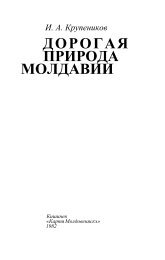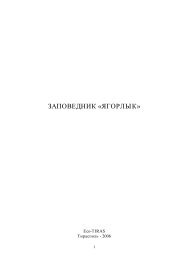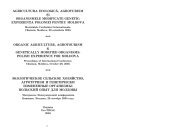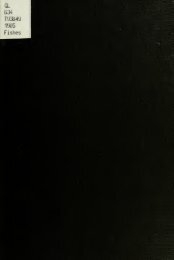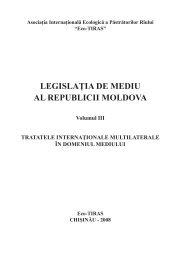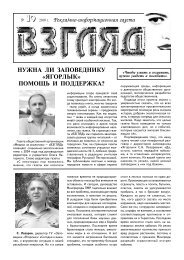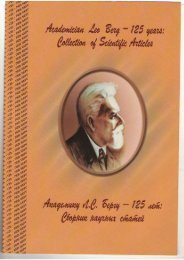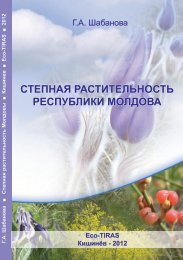Fig. 1. Evolution of shrew community structure in the last decadestoothed shrew was represented only by few individualsrecorded in “Codri” forest reserve. Its abundance didn’toverpass 2% from the shrew population. The pigmyand lesser white-toothed shrews had approximately thesame frequency and constituted about 20% from thewhole shrew population.In the 1980’s the abundance of common shrew wasmaintaining at high level and the species constitutedmore than half of shrew population (fig. 1). It was theonly species among shrews that was recorded in forestshelter belts (Munteanu, Savin, 1990). In opposite,the Mediterranean water shrew dominance decreasedbelow 20 %, this species being common only in naturalreserves in biotopes near water sources, while in theother ecosystems it became very rare. The abundanceof Pigmy shrew increased by about 10 %, especially in„Codri” forest reserve in wet biotopes (Averin et al., 1984),but it still was rather rare on the republic territory. Theabundance of Crocidura genus species was very low,below 10 % each species.In 1990’s the changes of economic conditions leadto the changes of ecosystems’ structure and to themodification of the Republic of Moldova landscape. Vastsingle-crop agricultural fields from the agrarian complexof 70-80’s that occupied large territories were dividedin parcels cultivated with various annual, biannual andperennial cultures. Many lands were abandoned anduncultivated. The process of natural habitat destructionwas rather intense. In such stressful conditions the shrewspecies density decreased drastically by comparingwith other mammal groups. In this period the commonshrew proved to be the most well adapted species withthe largest limits of ecological valence. Thus, it hadthe highest abundance among soricid mammals andconstituted almost 80 % from the shrew population. Thedensity of other shrew species was very low: the pigmyshrew constituted 10 %, the Mediterranean water shrew– about 8 %, the lesser white-toothed shrew – about 5%, while the white toothed shrew – only 1-2 % (fig. 1).The last species was very rare in the past century, soit was included in the Red Book of Moldova as criticallyendangered.After 2000 many abandoned lands and reverted totheir more or less natural state as natural biotopes, suchas pastures, meadows, grazing lands etc. At the sametime, the processes of anthropization, urbanization anddegradation of the natural ecosystems occur all over theterritory of the republic. In this context the modification ofthe shrew community’s structure continued.The common shrew remain the dominant species inthe population, but its abundance decreased significantly(to 43 %) by comparing with the end of XXth century.It is more tolerant to the environment conditions andto anthropogenic activity by comparing to other shrewspecies. It was recorded in the majority of studied naturaland anthropogenic biotopes (F=94 %). The pigmy shrewfrequency was also rather high – 88 %, but it is morerare, with the abundance of 35 % (fig. 1). The density ofbicolor white-toothed shrew increased up to 8,8 % and itsfrequency was rather high with the value of 9,7 % while inits preferred habitats the frequency of the species reach42 % (Nistreanu et al., 2008). The lesser white-toothedshrew has the same biotopic preferences as the previousspecies and it was more frequent (17,8 %) and abundant(12,5 %). The Mediterranean water shrew was the rarestshrew among other species after 2000. Its frequencywas very low (below 5 %), it being registered only nearaquatic basins of natural reserves, and the abundancewas of 2,4 %.In 2008 the structure of shrew communities onthe territory of Moldova is totally different (fig. 2). Thedominant species was the lesser white-toothed shrewwith 51.32 %, which constituted more than half of shrewpopulation. Its frequency constituted 40 % in naturalecosystems and more than 85% in urban environment.The species N. anomalus wasn’t registered in any of thestudied ecosystems. The other species had approximatelythe same abundance (fig.2). The trappability index variedfrom 2 % to 16 % from all the micromammal species.In 2009 the proportion of shrew species within thecommunity chanced again. The dominant species was thecommon shrew with over 44%, followed by bicolor whitetoothedshrew, with about 30 % (fig. 2). In opposite to theprevious year C. suaveolens had the lowest abundance.— 149 —
20082009Fig. 2. Structure of shrew communities in the last two yearsIt constituted only 11.11 %, while the pigmy shrewconstituted about 15 %. The trappability index varied from1 % to 15 % from all the micromammal species.We have to mention the high abundance of bicolourwhite-toothed shrew in the last several years. Its densityincreased gradually since the beginning of the XXI centuryand reaches its maximum in 2009. It was recorded notonly in natural and wet biotopes, but also in more aridones and in agocenoses. In abandoned lands the specieswas even more abundant that the common shrew andits trappability index constituted 10 % from all the smallmammals.Like in the previous year the Mediterranean watershrew wasn’t recorded in the studied biotopes. Itsabundance in the republic ecosystems decreaseddrastically in the last 20 years and it becomes a very rareand critically endangered species. This fact is causedby the degradation of wet habitats and of water basinspollution. We recommend it to be introduced in the thirdedition of Red Book of Moldova.ConclusionsThe structure of shrew community showed significantchanges during the last decades. The most well adaptedspecies is the common shrew. The bicolor whitetoothedshrew, which was critically endangered species,introduced in the red Book of Moldova, became one ofthe most common among shrews in the last years. Inopposite the Mediterranean water shrew that was oneof the most abundant in the past century, at present iscritically endangered, because of the destruction andtransformation of its natural habitats. The pygmy andlesser white-toothed shrews are wide spread in varioustypes of ecosystems, but their abundance is always below20%. The shrew species are good ecological indicators.Further measures on the protection of shrew habitatsmust be taken.Bibliography1. Munteanu A. Mamifere. Natura Rezervaţiei „Plaiul Fagului”,2005, p. 244-265.2. Nistreanu V. Soricidele (Soricidae, Insectivora) din colecţiamuzeului Laboratorului Vertebrate Terestre al Institutului de zoologie alA.S.M. VI Conf. of Zoologists of Moldova, Chisinau, 2007, p. 43-44.3. Nistreanu V., Spreading of insectivore species (Erinaceidae,Talpidae, Soricidae, Insectivora) in Nistru river basin. TransboundaryDniester river basin management and the EU Water FrameworkDirective. International Conference, 2-3 October 2007, p. 2<strong>13</strong>-217.4. Nistreanu Victoria, Munteanu A., Savin A., Caraman Natalia,Beneş O., Gheorghiţă S., Burlacu Victoria, Uspenscaia Inga. Datepreliminare privind răspândirea soricidelor (Soricidae, Insectivora)pe teritoriul Republicii Moldova. Simpozion Internaţional consacratjubileului de 60 de ani al academicianului Ion Toderaş. Chişinău, 2008,p. 68-70.5. Nistreanu V. Spreading of shrews from genus Sorex onthe territory of Republic of Moldova. Annual Zoological Congressof “Grigore Antipa” Museum, 12-<strong>13</strong> November 2009, Bucharest,Romania, p.50.6. Аверин Ю.В., Мунтяну А.И., Чегорка П.Т., Гавриленко В.С.,Лункашу М.И., Савин А.И. Млекопитающие. Природа ЗаповедникаКодры. Кишинэу «Штиинца» 1984, стр. 57-64.7. Лозан М.Н. Насекомоядные. Млекопитающие. «Животныймир Молдавии». Кишинэу «Штиинца», 1979, стр. 25-40.8. Лозан М.Н. Насекомоядные млекопитающие Молдавии(Insectivora, Mammalia). Экология птиц и млекопитающих Молдавии.Кишинэу «Штиинца», 1975, стр. 96-118.9. Мунтяну А.И., Савин А.И. Млекопитающие. «Фауна биоценотическихоазисов и ее практическое значение». Кишинэу «Штиинца»,1992, стр. 179-202.10. Нистряну В., Бурлаку В., Караман Н. Распространениебелозубок (Soricidae, Insectivora) на территории Молдовы. Современныепроблемы зоо– и филогеографии млекопитающих. Пенза.15-20 мая, 2009, стр. 60.11. Тихонов И.А., Котенкова Е.В., Успенская И.Г., КоноваловЮ.Н., Бурлаку В.И., Бенеш О.А., Георгица С.Д., Караман Н.К., ТихоноваГ.Н., Хрыстин В.А., Нистреану В., Мунтяну А.И. Грызуны и насекомоядныенезастроенных территорий г. Кишинева. Proceedingsof 4 th International Scientific-Practical Conference “Urboecosystems:problems and Prospects of Development”, Ishim, 19-20 March 2009,p.310-315.12. Тихонов И.А., А.И. Мунтяну, И.Г. Успенская, Ю.Н. Коновалов,В.И. Бурлаку, О.А. Бенеш, С.Д. Георгица, Н.К., Караман, Г.Н.Тихонова,В.А. Хрыстов, В.Б. Нистреану, Е.В. Котенкова. Видовое разнообразиемелких млекопитающих на примере г. Кишинэу. Геоэкологическиеи биоэкологические проблемы Северного Причерноморья. МатериалыIII Межд. научно-практической конференции. 22–23 октябряТирасполь 2009, стр. 200-203.<strong>13</strong>. Тихонова Г.Н., И.А. Тихонов, Е. В. Котенкова, И. Г. Успенская,Ю.Н. Коновалов, В. И. Бурлаку, В. Нистреану, О.А. Бенеш,С.Д. Георгица, Н. К. Караман, В.А. Хрыстов, А.И. Мунтяну. Сравнительныйанализ населения мелких млекопитающих незастроенныхтерриторий двух Европейских городов (Москвы и Кишинева).Diversitatea, valorificarea raţională şi protecţia lumii animale.Simpozionul internaţional consacrat celei de-a 70-a aniversări din ziuanaşterii profesorului universitar Andrei Munteanu. Chişinău, Ştiinţa2009, p. 117-120.— 150 —
- Page 3 and 4:
Descrierea CIP a Camerei Nationale
- Page 5 and 6:
Уважаемые коллеги,
- Page 7 and 8:
щегосударственной
- Page 9 and 10:
доме, в котором мы в
- Page 11 and 12:
шие глубины на заде
- Page 13 and 14:
с малыми восстанов
- Page 15 and 16:
Литература1. Жадин
- Page 17 and 18:
Рис. 3. Многолетняя
- Page 19 and 20:
тера и глубины изме
- Page 21 and 22:
ПОДДЕРЖАНИЕ БИОРАЗ
- Page 23 and 24:
Таблица 5. Оптималь
- Page 25 and 26:
Таблица. Результат
- Page 27 and 28:
ФОРМИРОВАНИЕ БИОЦЕ
- Page 29 and 30:
Подавляющее больши
- Page 31 and 32:
Рис.1. Днестр вблизи
- Page 33 and 34:
сопоставимости дан
- Page 35 and 36:
ции с международны
- Page 37 and 38:
А.Н. Бургеля, К.П. Бу
- Page 39 and 40:
Выводы1. Уже на само
- Page 41 and 42:
тегории, виды и пор
- Page 43 and 44:
санитарно-эпидемио
- Page 45 and 46:
Таблица 4. Распреде
- Page 47 and 48:
реационных, монито
- Page 49 and 50:
Шабановой Г.А. и Кух
- Page 51 and 52:
могут быть убраны,
- Page 53 and 54:
Турунчук. Связь с с
- Page 55 and 56:
Праздник «День Рек
- Page 57 and 58:
500ЈPРис. Распределе
- Page 59 and 60:
Н. Гроссу * , Р. Шакир
- Page 61 and 62:
Рис.1. Помесячное ра
- Page 63 and 64:
Calitatea apei r. Nistru conform gr
- Page 65 and 66:
Карта геохимическо
- Page 67 and 68:
лесу был дуб, сегод
- Page 69 and 70:
При предварительно
- Page 71 and 72:
щих улучшить социа
- Page 73 and 74:
ней опасных загряз
- Page 75 and 76:
ФотоприложениеФот
- Page 77 and 78:
в Украине - одесска
- Page 79 and 80:
тия по гидрохимиче
- Page 81 and 82:
ветствующих санита
- Page 83 and 84:
ния полей, так и для
- Page 85 and 86:
В. Экономический ан
- Page 87 and 88:
Таким образом, плат
- Page 89 and 90:
Рис. 2. Динамика нор
- Page 91 and 92:
Табл. 1а. Статистиче
- Page 93 and 94:
Выводы1. Наибольшее
- Page 95 and 96:
Для днестровской в
- Page 97 and 98:
ЭКОЭТИЧЕСКОЕ ВОСПИ
- Page 99 and 100: Таблица 1. Валовое с
- Page 101 and 102: почвенный покров п
- Page 103 and 104: always been the public concern of b
- Page 105 and 106: и уникальными по си
- Page 107 and 108: ются основными фак
- Page 109 and 110: Рис. 4. Пораженность
- Page 111 and 112: ight to use”. Varone et al. (2002
- Page 113 and 114: mass media, etc., which belong to d
- Page 115 and 116: В связи с тем, что К
- Page 117 and 118: период поездки вых
- Page 119 and 120: doutchinae (d’Orb.), выше з
- Page 121 and 122: вместе с осадками в
- Page 123 and 124: Таблица 4. Содержан
- Page 125 and 126: efectuat în baza următorilor indi
- Page 127 and 128: видуальных различи
- Page 129 and 130: - соответствующее з
- Page 131 and 132: ФАУНА КЛЕЩЕЙ ДРЕВЕ
- Page 133 and 134: Таблица 1. Данные ра
- Page 135 and 136: РЕКРЕАЦИОННЫЕ РЕСУ
- Page 137 and 138: ЭТАПЫ ЭВОЛЮЦИИ БИО
- Page 139 and 140: Плотина Дубоссарск
- Page 141 and 142: чимые. При этом «пе
- Page 143 and 144: Схематически получ
- Page 145 and 146: Таблица 5. Данные на
- Page 147 and 148: Risks for biodiversity with tested
- Page 149: 14. Ярошенко M.Ф., Дед
- Page 153 and 154: с природой (различн
- Page 155 and 156: делить в их предела
- Page 157 and 158: Таблица. Оценка эне
- Page 159 and 160: лах Приднестровья
- Page 161 and 162: ВыводыКраеведческ
- Page 163 and 164: вий среды жизнедея
- Page 165 and 166: Senecio besserianus Minder. Cypripe
- Page 167 and 168: Рис.1. Почвенная кар
- Page 169 and 170: половины площади п
- Page 171 and 172: Рис. 2. Современное
- Page 173 and 174: ПРИЧИНЫ ГЕОМОРФОЛО
- Page 175 and 176: RÂURILE MICI CU ŞANSE MARIDE A FI
- Page 177 and 178: ЭКОНОМИКО-ЭКОЛОГИЧ
- Page 179 and 180: прибрежной зоной (п
- Page 181 and 182: Строительство в пр
- Page 183 and 184: государственного у
- Page 185 and 186: ческий, социальный
- Page 187 and 188: ми, послужило весом
- Page 189 and 190: губительно влияющи
- Page 191 and 192: ных за контролем и
- Page 193 and 194: PECULARITIES OF DYNAMICS OF PHOSPHO
- Page 195 and 196: Fig. 4. Spatial and seasonal dynami
- Page 197 and 198: • inventory of point discharges s
- Page 199 and 200: СТЕРИЛИЗАЦИЯ КАК С
- Page 201 and 202:
гормоны (в незначит
- Page 203 and 204:
ПРОТОКОЛ ПО ПРОБЛЕ
- Page 205 and 206:
воды ежегодно умир
- Page 207 and 208:
РАЗРАБОТКА ПЛАНОВ
- Page 209 and 210:
ставляет материаль
- Page 211 and 212:
• Совершенствован
- Page 213 and 214:
«Алые паруса». Таки
- Page 215 and 216:
which the Committee is then require
- Page 217 and 218:
нием, культурой и х
- Page 219 and 220:
- Николаевская церк
- Page 221 and 222:
Сброшенный на 50 м б
- Page 223 and 224:
СТРУКТУРА ГЕОИНФОР
- Page 225 and 226:
4. Пространственная
- Page 227 and 228:
На фазе пика числен
- Page 229 and 230:
А.А. Тищенков, В.В. М
- Page 231 and 232:
Распределение видо
- Page 233 and 234:
цветковый (ККП, ЧКУ,
- Page 235 and 236:
очередной задачей
- Page 237 and 238:
схемой планировани
- Page 239 and 240:
эксплуатационным п
- Page 241 and 242:
ных дамб, с возвращ
- Page 243 and 244:
ледствия от урбани
- Page 245 and 246:
ОСНОВНЫЕ ФОРМЫ ДЕГ
- Page 247 and 248:
УЧАСТИЕ НЕПРАВИТЕЛ
- Page 249 and 250:
струкции как от сбр
- Page 251 and 252:
Рогоз широколистны
- Page 253 and 254:
Таблица 3. Изменени
- Page 255 and 256:
В рамках первых тре
- Page 257 and 258:
Основные экскурсио
- Page 259 and 260:
2. Кравченко Е.Н. При
- Page 261 and 262:
Decision-Maker user group are respo
- Page 263 and 264:
может ее запускать,
- Page 265 and 266:
поражения населени
- Page 267 and 268:
тию РДЮЦ «ГУТТА - кл
- Page 269 and 270:
мость разработки н
- Page 271 and 272:
Биология. Подорожн
- Page 273 and 274:
банизированных тер
- Page 275 and 276:
Результаты исследо
- Page 277 and 278:
площадь ассимиляци
- Page 279 and 280:
Рис. 3. Дендрограмма
- Page 281 and 282:
Рис.1. Сезонная дина
- Page 283 and 284:
Молдовы и Приднест
- Page 285 and 286:
Ребята приехали в 10
- Page 287 and 288:
Рис. 1. Численность
- Page 289 and 290:
жений, в том числе э
- Page 291 and 292:
[4]. Несомненно, выжи
- Page 293 and 294:
КОНСТИТУЦИОНАЛЬНА
- Page 295 and 296:
В настоящее время б
- Page 297 and 298:
8. Суворцева В.Ю., Ру
- Page 299 and 300:
Окончание табл. 2Ок
- Page 301 and 302:
содержаниеПРЕДИСЛ
- Page 303 and 304:
А.П. Погребняк, В.Ф.
- Page 305:
Научное изданиеБАС


![[download]13,2 Mb - Eco - Tiras](https://img.yumpu.com/50284532/150/500x640/download132-mb-eco-tiras.jpg)
